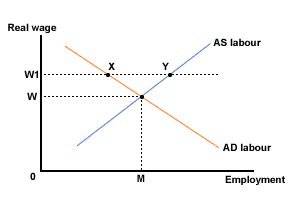(More on) Natural rate of unemployment
Monetarists (Free Market or Neoclassical Economists can be used
synonymously´ask your teacher for explanation if you wish more on this)
believe that in the long run real output tends to an equilibrium level,
because employment tends to an equilibrium level in the Labour market.
The level of unemployment that exists in equilibrium is referred to as the natural rate of unemployment, which is the amount of structural and frictional unemployment which is left in the economy when supply and demand are in balance (No Cyclical or demend deficient unemployment). For monetarists, the natural rate of unemployment is the full employment rate and would be consistent with stable wages and prices.
The monetarist view of the labour market differs from the Keynesian view in that it considers unemployment from the supply-side of the economy, rather than resulting from deficient demand. Also there is a disagreement of the functioning of wages and prices as signals - Keynesians regard nominal wages and prices as inflexible (sticky) especially downwards so the labour market cannot adjust to equilibrium.
Neoclassicals refer to adjustments in real wages as the key signalling device.
The labour market is considered like any other market where the equilibrium price, i.e. the wage rate, is determined by demand and supply. The amount of labour demand by employers will depended on the level of real wages.
Hence the higher the real wage, the lower the demand for labour
the lower the real wage, the higher the demand for labour
the higher the real wage, the higher the supply of labour
the lower the real wage, the lower the supply of labour
The equilibrium real wage will be established where demand for labour is equal to the supply of labour.
Any unemployment remaining, when the labour market is in equilibrium, is referred to as the natural rate of unemployment.

Figure 1 Natural rate of unemployment
With reference to figure 1, the labour market is in equilibrium at 0W,OM. If the real wage was above the equilibrium, then excess supply of labour would result as the supply of labour is greater than the demand.
The implication from this is that unemployment is caused by real wages being too high, and that the cure for unemployment is for workers to accept lower real wages. Monetarists would say that any unemployment above OM is voluntary, and occurs because workers are not willing to work for a low enough wage. Thus any unemployment at OM is referred to as the natural rate of unemployment, and is the unemployment which remains when the labour market is in equilibrium.
What determines natural rate and how can it be reduced?
The natural rate of unemployment cannot be defined as some percentage of the labour force. It depends on a number of factors which are liable to change over time. For example:
- Technology and information
- Comparative advantage and international trade
- The degree of occupational and geographical mobility
- Information regarding job opportunities
- Restrictive practices imposed by trade unions
According to monetarists it would, therefore, follow that the natural rate of unemployment could be reduced by removing 'frictions' or obstacles to supply. This could be achieved by various supply-side measures, such as:
- Reducing the power of trade unions to resist reductions in real wages (i.e. unions should be made more docile and accepting of the conditions which owners of capital wish to impose on them!).
- Reducing rigidites such as minimum wage rates
- A combination of reduced benefits and lower taxes to induce the unemployed to take lower paid jobs.
- Increasing geographical and occupational mobility (e.g. with retraining).
- Establishing an efficient system of information flows.